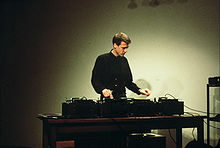Christian Marclay
[2] Christian Marclay was born on January 11, 1955, in San Rafael, Marin County, California, to a Swiss father and an American mother and raised in Geneva, Switzerland.
[6] Citing the influence of John Cage, Yoko Ono and Vito Acconci, Marclay has long explored the rituals around making and collecting music.
[10] Marclay has occasionally cut and re-joined different LP records; when played on a turntable, these re-assembled records will combine snippets of different music in quick succession along with clicks or pops from the seams[14] – typical of noise music – and when the original LPs were made of differently-colored vinyl, the reassembled LPs can themselves be considered as works of art.
A review in Spin at the time cited Marclay's "coolest theatrical gesture" in his live performances of phonoguitar: the artist strapped a record player onto himself and played, for example, a Jimi Hendrix album.
During his residency at Eyebeam, Marclay created Screen Play (2005), a twenty minute video of black and white images overlaid with colorful computer graphics.
It was an early experiment in the effect of synchronization, where viewers naturally attempted to find intersections between the two works, and it developed the editing style that Marclay employs for The Clock.
[22][23] Thom Jurek writes: "While many intellectuals have made wild pronouncements about Marclay and his art – and it is art, make no mistake – writing all sorts of blather about how he strips the adult century bare by his cutting up of vinyl records and pasting them together with parts from other vinyl records, they never seem to mention that these sound collages of his are charming, very human, and quite often intentionally hilarious.
[26] At the 2011 Venice Biennale, representing the United States, Marclay was recognized as the best artist in the official exhibition, winning the Golden Lion for The Clock.
[27] Accepting the Golden Lion, Marclay invoked Andy Warhol, thanking the jury "for giving The Clock its fifteen minutes".
